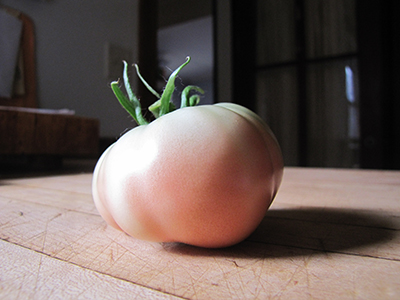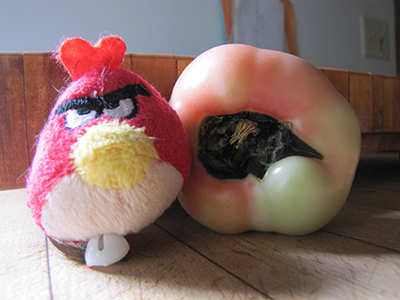Guy Clark sings that “there are only two things that money can’t buy….true love and homegrown tomatoes.” I doubt it. Let’s see you buy some giardia. But there’s one thing that comes free with life, and tomatoes: disappointment.
In late July and early August most gardeners begin hoping for the first tomatoes. I begin poking in amongst the leaves and hoping to see a flash of red. Sometimes when I reach for the first one the bottom turns out to be a mushy mess: blossom end rot. BER is a very common trouble for home gardeners. As you can see from the pictures, it happened to a couple of the heirloom plants I snuck in this year.
If you look BER up in any gardening guide, you’ll read that it’s caused by a calcium deficiency. I did a little poking around in the relevant literature to see what the pointy-heads think the problem is.
According to a review by Ho and White in the Annals of Botany (2005), it is a calcium deficiency. Please note, two “n”s in “Annals.” If you spray plants with a dilute calcium chloride solution you can relieve the symptoms. Usually, though, it’s not that there isn’t enough calcium in the soil. Saure in Scientia Horticulturae (2001) points out that other stresses leave the plant in a situation where it can’t move calcium to where it is needed.
When the fruit is expanding rapidly, its cells grow very fast especially at the blossom end. That means they add cell wall and bring in a lot of water and sugar. In many fruits the walls are made of pectin not cellulose as in the rest of the plant. That’s why we can eat them. Pectin is held together by calcium, but calcium is also needed inside the cells. When the plants are growing too quickly the calcium goes into the cell walls. The inside of the cells shrinks back and, ultimately, dies. This is called necrosis and leads to the brown blossom end.
This injured tissue often gets invaded by molds and/or bacteria and gets to looking as awful as the fruit beside the angry bird.
So what do you do about it? Lower stresses on the plant early on. Make sure it doesn’t get root bound and doesn’t have fruit before you transplant it. Fertilize the seedlings to make sure they have enough micronutrients. Fertilize, test and amend your soil. Make sure your plants get plenty of water and mulch them well. If the pH of your soil is low, lime. This will add calcium. Most importantly, relax, they’re just tomatoes and usually the second bunch is just fine.
Also remember that this is just one theory, there’s also the intelligent end rot theory that says the feisty tomato god just wishes to punish you. If you believe that theory the only cure is to send me ten percent of your income each week, care of the Advocate. Cheers.
Guy Clark sings that “there are only two things that money can’t buy….true love and homegrown tomatoes.” I doubt it. Let’s see you buy some giardia. But there’s one thing that comes free with life, and tomatoes: disappointment.

In late July and early August most gardeners begin hoping for the first tomatoes. I begin poking in amongst the leaves and hoping to see a flash of red. Sometimes when I reach for the first one the bottom turns out to be a mushy mess: blossom end rot. BER is a very common trouble for home gardeners. As you can see from the pictures, it happened to a couple of the heirloom plants I snuck in this year.

If you look BER up in any gardening guide, you’ll read that it’s caused by a calcium deficiency. I did a little poking around in the relevant literature to see what the pointy-heads think the problem is.
According to a review by Ho and White in the Annals of Botany (2005), it is a calcium deficiency. Please note, two “n”s in “Annals.” If you spray plants with a dilute calcium chloride solution you can relieve the symptoms. Usually, though, it’s not that there isn’t enough calcium in the soil. Saure in Scientia Horticulturae (2001) points out that other stresses leave the plant in a situation where it can’t move calcium to where it is needed.
When the fruit is expanding rapidly, its cells grow very fast especially at the blossom end. That means they add cell wall and bring in a lot of water and sugar. In many fruits the walls are made of pectin not cellulose as in the rest of the plant. That’s why we can eat them. Pectin is held together by calcium, but calcium is also needed inside the cells. When the plants are growing too quickly the calcium goes into the cell walls. The inside of the cells shrinks back and, ultimately, dies. This is called necrosis and leads to the brown blossom end.
This injured tissue often gets invaded by molds and/or bacteria and gets to looking as awful as the fruit beside the angry bird.
So what do you do about it? Lower stresses on the plant early on. Make sure it doesn’t get root bound and doesn’t have fruit before you transplant it. Fertilize the seedlings to make sure they have enough micronutrients. Fertilize, test and amend your soil. Make sure your plants get plenty of water and mulch them well. If the pH of your soil is low, lime. This will add calcium. Most importantly, relax, they’re just tomatoes and usually the second bunch is just fine.
Also remember that this is just one theory, there’s also the intelligent end rot theory that says the feisty tomato god just wishes to punish you. If you believe that theory the only cure is to send me ten percent of your income each week, care of the Advocate. Cheers.
Related




